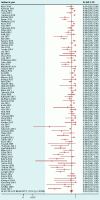Colorectal endoscopic submucosal dissection: a systematic review and meta-analysis
- PMID: 27747275
- PMCID: PMC5063641
- DOI: 10.1055/s-0042-114774
Colorectal endoscopic submucosal dissection: a systematic review and meta-analysis
Abstract
Background and study aims: Endoscopic submucosal dissection (ESD) is an advanced endoscopic technique that allows en-bloc resection of gastrointestinal tumor. We systematically review the medical literature in order to evaluate the safety and efficacy of colorectal ESD. Patients and methods: We performed a comprehensive literature search of MEDLINE, EMBASE, Ovid, CINAHL, and Cochrane for studies reporting on the clinical efficacy and safety profile of colorectal ESD. Results: Included in this study were 13833 tumors in 13603 patients (42 % female) who underwent colorectal ESD between 1998 and 2014. The R0 resection rate was 83 % (95 % CI, 80 - 86 %) with significant between-study heterogeneity (P < 0.001) which was partly explained by difference in continent (P = 0.004), study design (P = 0.04), duration of the procedure (P = 0.009), and, marginally, by average tumor size (P = 0.09). Endoscopic en bloc and curative resection rates were 92 % (95 % CI, 90 - 94 %) and 86 % (95 % CI, 80 - 90 %), respectively. The rates of immediate and delayed perforation were 4.2 % (95 % CI, 3.5 - 5.0 %) and 0.22 % (95 % CI, 0.11 - 0.46 %), respectively, while rates of immediate and delayed major bleeding were 0.75 % (95 % CI, 0.31 - 1.8 %) and 2.1 % (95 % CI, 1.6 - 2.6 %). After an average postoperative follow up of 19 months, the rate of tumor recurrence was 0.04 % (95 % CI, 0.01 - 0.31) among those with R0 resection and 3.6 % (95 % CI, 1.4 - 8.8 %) among those without R0 resection. Overall, irrespective of the resection status, recurrence rate was 1.0 % (95 % CI, 0.42 - 2.1 %). Conclusions: Our meta-analysis, the largest and most comprehensive assessment of colorectal ESD to date, showed that colorectal ESD is safe and effective for colorectal tumors and warrants consideration as first-line therapy when an expert operator is available.
Conflict of interest statement
Figures






References
-
- ASGE Technology Committee . Maple J T, Abu Dayyeh B K. et al.Endoscopic submucosal dissection. Gastrointest Endosc. 2015;81:1311–1325. - PubMed
-
- Uraoka T, Parra-Blanco A, Yahagi N. Colorectal endoscopic submucosal dissection: is it suitable in western countries? J Gastroenterol Hepatol. 2013;28:406–414. - PubMed
-
- Stroup D F, Berlin J A, Morton S C. et al.Meta-analysis of observational studies in epidemiology: a proposal for reporting. Meta-analysis Of Observational Studies in Epidemiology (MOOSE) group. JAMA. 2000;283:2008–2012. - PubMed
LinkOut - more resources
Full Text Sources
Other Literature Sources
Research Materials
Miscellaneous

